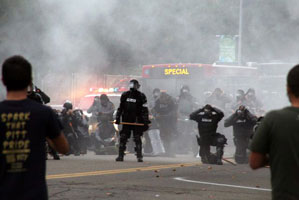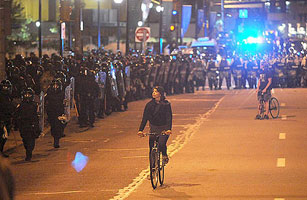No to Criminalization of Public Spaces and Resources
• Reject Police State Measures Attacking the Public
•
G-20 Live Police State Exercise
•
Men Arrested for G-20 Twittering Defend Right to Free Speech
•
Police Brutally Attack Oakland Students and Residents • The G-20: A Guest with an Iron Fist • Pittsburgh Police Statement on Massive Deployment Against Youth
Reject Police State Measures Attacking the Public
At a recent protest in Buffalo, New York opposing the visit of war criminal Tony Blair to the University at Buffalo, protesters were arbitrarily forced into what police called a “Free Speech Zone,” off to one side of the entrance to Alumni Arena, where Blair was speaking. This was done at a public university, on a public sidewalk, where no crime or violence had occurred and there was no threat of any occurring. Protesters are being “penned” in, while war criminals like Blair, and Karl Rove and Bill Clinton before him, are being welcomed and given a platform to promote their crimes. These actions do not represent the public, which is decidedly anti-war, and serve to undermine the right to protest. As demonstrators often make clear, All America is a Free Speech Zone.
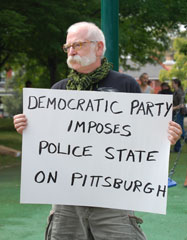 In Pittsburgh, the attack on the public as a whole was more widespread and evident. Public parks, plazas and sidewalks were among the public spaces the police determined could not be used by the public for public activity, like demonstrating or gathering or simply walking home. Public schools were closed and put on lockdown, as was downtown. And these determinations were made without cause. There was no threat to public safety. No fire for example or danger of that kind. Demonstrators in no way threatened any school and nor did police have any evidence that anyone planned to do so. Yet simply the government determination of a “potential for violence” was used to justify the school lockdown and downtown lockdown. It was used to justify the massive show of force and violence on the part of the police toward demonstrators and the public as a whole.
In Pittsburgh, the attack on the public as a whole was more widespread and evident. Public parks, plazas and sidewalks were among the public spaces the police determined could not be used by the public for public activity, like demonstrating or gathering or simply walking home. Public schools were closed and put on lockdown, as was downtown. And these determinations were made without cause. There was no threat to public safety. No fire for example or danger of that kind. Demonstrators in no way threatened any school and nor did police have any evidence that anyone planned to do so. Yet simply the government determination of a “potential for violence” was used to justify the school lockdown and downtown lockdown. It was used to justify the massive show of force and violence on the part of the police toward demonstrators and the public as a whole.
Teachers and students and the public as a whole were threatened far more by these arbitrary measures to close the schools, use school buses for police activity and contend with the police violence against the youth. This was a live police state exercise, using new weapons like the deafening sound weapon, and more extensive powers, like locking down public schools and confiscating school buses and public transit buses for use by the police.
The public did not make these decisions and elected public officials did not defend the public interest. And the local police forces have no authority to lock down schools without cause. Local officials instead submitted to demands of the federal police agencies, like the Secret Service, to impose such actions, in the name of “protecting” the heads of state of the G-20. And they did so at a time when the heads of state of the U.S. and other imperialist powers deserve to see the anger and rejection of the public to their wars and bailouts of the rich. It is in the context of the growing rejection of the existing system, as seen in the many banners opposing capitalism, that these police state measures are being utilized and intensified.
There was no necessity for the various closures and the display of force, other than to get the public used to such measures. These actions are based on the notion that the federal government “knows best” when it comes to such matters. Anyone directly involved, including legal observers and many journalists, could see that there was no necessity for anything more than the usual police presence. Instead measures were directed against public dissent and far more broadly against the public as a whole and its use of public spaces, including schools and parks.
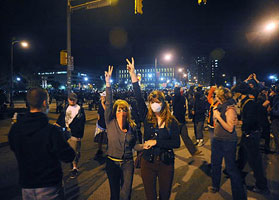 The police state actions represent an increase in the measures aimed not only at demonstrators but also the public as a whole. They are part of imposing experience with such arbitrary police state measures on the public, as a means to lessen resistance to them. They are to create an atmosphere that when the federal government dictates, such use of force against the people and use of their public resources for police repression are legitimate. On the contrary they are a serious assault on the public that must be opposed by all.
The police state actions represent an increase in the measures aimed not only at demonstrators but also the public as a whole. They are part of imposing experience with such arbitrary police state measures on the public, as a means to lessen resistance to them. They are to create an atmosphere that when the federal government dictates, such use of force against the people and use of their public resources for police repression are legitimate. On the contrary they are a serious assault on the public that must be opposed by all.
Voice of Revolution salutes the many youth and protesters in the forefront of opposing these measures and urges all to defend them and stand up for the public and its rights to engage in public activity in public spaces.
[TOP]
G-20 Live Police State Exercise
Although federal and local police agencies admitted they had no knowledge of a terrorist threat, or even of planned violence, a massive force of federal, state and local police agencies took place in Pittsburgh at the G-20. Pittsburghers and protesters alike were made the subjects of a live police-state exercise. More then 4,000 police and state troopers from across the country were gathered together, including from Alabama, Arizona, Florida, Illinois, Kentucky, North Carolina, Maryland, Pennsylvania and Ohio. Chicago and Philadelphia had large contingents, and police from Baltimore, Charlotte, Cleveland, Harrisburg, Louisville and Tucson all participated. Each police officer had to volunteer and pass screening to participate in these actions. These police were used against residents of a city they were not accountable to or familiar with. In addition there were an estimated 2,400 National Guard called in.  Pittsburghers pointed out that this was the largest mobilization of outside police forces in the city since the Homestead strike of 1892, where hundreds of Pinkerton guards (private police forces) were brought in to attack striking steelworkers. (Photo at left shows Pinkertons surrendering to strikers.)
Pittsburghers pointed out that this was the largest mobilization of outside police forces in the city since the Homestead strike of 1892, where hundreds of Pinkerton guards (private police forces) were brought in to attack striking steelworkers. (Photo at left shows Pinkertons surrendering to strikers.)
The thousands of police forces were not brought in on the basis of any crime or any plans for criminal activity but simply on the basis of what police determined was a “potential for violence.” An indication of what police used to determine such potential was seen in their statement justifying the brutal attack on unarmed University of Pennsylvania students on their campus, where about 50 were arrested. Police said a massive force was needed, as there was “chatter” about a demonstration taking place in a public plaza (which is protected activity under the Constitution’s First Amendment and does not require a permit). And that “information was received throughout the day that individuals were purchasing numerous BIC lighters and asking if lighter fluid could be purchased.” The police report itself states “There is nothing to link the purchase of lighters to any activity,” (see Police Report below). Nonetheless, hundreds of police in full riot gear were massed in the area, lined up three and four deep and then marched on the students who were either in the public plaza or their own student union.
In addition to the attack on public protest and the right to dissent, including using tear gas, pepper spray, rubber bullets, beanbag bullets, and a deafening sound weapon, the Pittsburgh G-20 live exercises included a number of significant attacks on the public as a whole. The National Lawyers Guild, whose members were legal observers at the various actions, reported: “Police deployed chemical irritants, including teargas, and long-range acoustic devices (LRAD) in residential neighborhoods on narrow streets where families and small children were exposed…Outside the Courtyard Marriott in Shadyside, police deployed smoke bombs in the absence of protest activity, forcing bystanders and hotel residents to flee the area.”
In addition the following actions were taken:
• Public schools were closed on Wednesday, September 23 and kept closed until the following Tuesday. The school buildings were put on lockdown, meaning no one in or out.
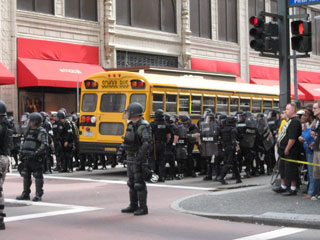 • Public school buses were confiscated and used to transport the police. This was particularly jarring to see, as the brain simply will not associate a public school bus with riot police.
• Public school buses were confiscated and used to transport the police. This was particularly jarring to see, as the brain simply will not associate a public school bus with riot police.
• Public transportation buses were also confiscated and used to transport police. Many people had the experience of seeing a public bus coming to a bus stop at a light, only to find out it was not for the public, but rather being sent to gather police.
• A large part of downtown was also put on lockdown, with workers forced to miss two days of work, shops forced to close, people forced to evacuate.
• Police repeatedly traveled in large caravans that included police cars, school buses, public buses, Ryder and Budget vans, rushing rapidly down the streets, sirens blaring, in an obvious effort to intimidate people citywide. This was particularly notable September 25, before the permitted march even started. A large caravan of about ten vehicles roared up 5th Avenue — the street designated for the march. They did so at high speed going the wrong way up a one-way street.
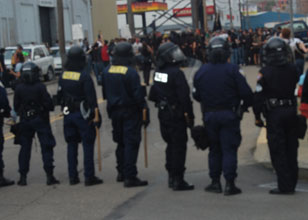 • During the two-day summit police arbitrarily blocked off streets, at times cordoning off several square block areas miles from the summit and refusing to allow anyone to leave, including workers getting off work, people stopping at convenience stores, simply walking down the street, etc. This occurred particularly on Thursday, where several small groups of a few dozen youth contended with squadrons of hundreds of police. People who happened to be anywhere within 10 blocks of the area were prevented from leaving, including anyone from the march meeting police orders to disperse. Repeatedly, on Thursday and Friday, including at the university, police arbitrarily issued orders to disperse, then made it impossible for people to leave, then unleashed tear gas and made arrests.
• During the two-day summit police arbitrarily blocked off streets, at times cordoning off several square block areas miles from the summit and refusing to allow anyone to leave, including workers getting off work, people stopping at convenience stores, simply walking down the street, etc. This occurred particularly on Thursday, where several small groups of a few dozen youth contended with squadrons of hundreds of police. People who happened to be anywhere within 10 blocks of the area were prevented from leaving, including anyone from the march meeting police orders to disperse. Repeatedly, on Thursday and Friday, including at the university, police arbitrarily issued orders to disperse, then made it impossible for people to leave, then unleashed tear gas and made arrests.
Closing schools, using school buses and public transit buses, arbitrarily closing streets in communities with no notice and no cause, marching on a public university against youth gathered in a public plaza, these are all attacks on the public as a whole. Public spaces themselves are being criminalized, public vehicles confiscated and used against the public, massive police sent into neighborhoods when no crime has been committed and no one requires or called for police protection. These are police state measures directed at the public and getting the public used to police forces arbitrarily deciding what can be done by the public in public.
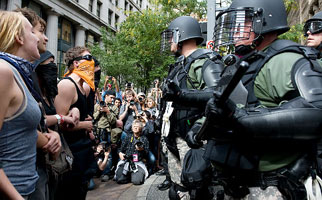 It is also an exercise in training the police to come under the command of the federal government, in this case the Secret Service and Homeland Security, and to carry out attacks on the youth and the public more generally when it is obvious there is no threat or violence or crime of any kind.
It is also an exercise in training the police to come under the command of the federal government, in this case the Secret Service and Homeland Security, and to carry out attacks on the youth and the public more generally when it is obvious there is no threat or violence or crime of any kind.
And despite all these attacks, what was clear is that Pittsburghers rejected these arbitrary measures. People were angered by the impunity of the police to arbitrarily dictate to all. No one was intimidated and indeed small groups of youth succeeded in going toe to toe with the police and keeping large numbers of them occupied for hours. It was the public, including the demonstrators and many thousands who participated in various actions that protected the public and defended the right to protest and the right to use and be secure in public places.
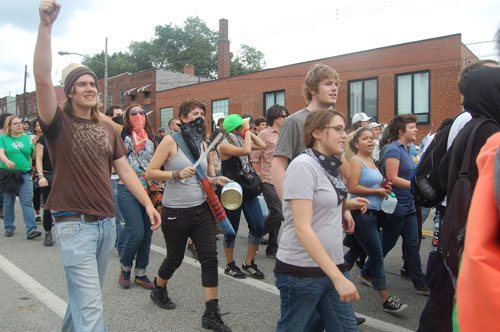
[TOP]
Men Arrested for G-20 Twittering Defend
Right to Free Speech
Two men who were arrested for organizing a communications center for protesters at the G-20, using twitter and cell phones to report police movements to demonstrators, defend their actions as the right to free speech. Police said the two men were “using headphones, microphones and maps to alert protesters about the movements of law enforcement,” and arrested them in Pittsburgh.
The two activists brought out that the police were using police scanners on public radio frequencies which people regularly listen to and utilize. They were exercising their right to use public information for a public protest, just as reporters use it for their purposes, as do neighborhood watch groups and many others. As an ACLU lawyer said, “How can it be a crime? It is not a secure communication.” He added, “If the police want to communicate privately, there are certainly ways to do that, and police radios are not one of those.” Police without doubt were frustrated by the organized efforts of the youth to outmaneuver them and keep large numbers occupied at standoffs for hours.
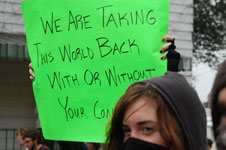 In the situation on September 24, where dozens of police and national guard were deployed for every one demonstrator, these men, set up in a hotel room near Pittsburgh, simply passing along information already available to the public, are being charged with “hindering apprehension, criminal use of a communication facility and possessing instruments of crime.” The police claim the “crime” the two were involved in was “assisting the protesters’ failure to disperse.” Anyone actually involved in the actions that day know that the police were the main agents preventing people from dispersing — whole blocks were shut down and no one, whether pedestrians, workers trying to go home, shoppers, and people leaving the protests, were permitted to leave for hours. As well, legal cases against the police actions are contesting the police claim that various protests and gatherings were illegal, as police simply proclaimed.
In the situation on September 24, where dozens of police and national guard were deployed for every one demonstrator, these men, set up in a hotel room near Pittsburgh, simply passing along information already available to the public, are being charged with “hindering apprehension, criminal use of a communication facility and possessing instruments of crime.” The police claim the “crime” the two were involved in was “assisting the protesters’ failure to disperse.” Anyone actually involved in the actions that day know that the police were the main agents preventing people from dispersing — whole blocks were shut down and no one, whether pedestrians, workers trying to go home, shoppers, and people leaving the protests, were permitted to leave for hours. As well, legal cases against the police actions are contesting the police claim that various protests and gatherings were illegal, as police simply proclaimed.
The FBI later raided the Queen’s New York home of one of the two, Elliot Madison. During a 16-hour search, the FBI swarmed the apartment and helicopters hovered overhead. The FBI raided the home supposedly investigating violations of “federal rioting laws.” Mr. Madison, a social worker, had his computerized client records taken as well as other personal property. He is also part of the People’s Law Collective that provides legal support to demonstrators.
Madison’s lawyer filed a motion in federal court in New York asking for the return of much of the evidence seized. The judge issued a temporary order of protection, preventing the FBI from going through the material.
The attack on public use of public police scanners is another example of the increased attack on the public as a whole that took place at the G-20 protests. As an ACLU spokesman brought out, he has not heard of police making arrests based on the use of Twitter. He noted that the American government encouraged the use of the social networking program for people protesting elections in Iran earlier this year. “We tend to applaud the use of Twitter when it is in Iran and involves protests [the government] likes,” he said. “But [the government] is much more nervous about it when it is protests they do not like.”
[TOP]
Police Brutally Attack Oakland Students and Residents
For the past two nights, Oakland has remained in a state of siege. Pittsburghers gathering to protest police brutality last night, along with the crowd of spectators they attracted, were greeted once more by uncontrolled police violence. As the smoke clears and locals prepare for another night of protest, many questions remain as to how police violence was allowed to go on unchecked and what the University of Pittsburgh will do to protect its students.
Numbers continue to pour in as the aftermath from the past two nights is tallied. According to legal observers, between 60 and 70 were arrested Thursday night; 110 more were arrested Friday. Many of those detained were students. Eight remain in jail from Thursday along with half of Friday’s arrestees.
Says media spokesperson Jesse Ericson, “On Thursday night, police surrounded and attacked a dance party in Schenley Plaza. Last night, locals and students gathered again to demonstrate against the random violence and terror we saw the night before, only to see the situation become far worse. The police force has gone off the deep end. After their failure to contain and control groups who successfully held the streets for hours on Thursday, the police are retaliating on young people who are unprepared and unequipped to deal with police brutality. Last night we saw open war on anyone unlucky enough to live in Oakland. After the dorms were locked down, many students had nowhere to disperse to, leaving them at the mercy of riot cops with batons, gas and rubber bullets.”
Individual reports of indiscriminate violence are coming in from the hundreds on the scene last night. Says Noah Williams, “I was on Forbes Avenue when I saw a young college student coming around the corner with blood all over his face. He’d been shot with a rubber bullet about one inch beneath his eye. A little farther up and he’d be dead now. He was just walking by Towers.” Video of this incident can be found at http://www.ireport.com/docs/DOC-333876, but it was by no means the only one. Tear gas and pepper spray were used heavily on the campus area between Fifth and Forbes. Rubber bullets were shot arbitrarily into trapped crowds. In one of last night’s most disturbing events, police assembled with an arrested student and posed for a photo after forcing him to his knees. Footage is available at http://www.ireport.com/docs/DOC-333880. As one police officer declared, “This is almost like martial law” (http://www.ireport.com/docs/DOC-333897).
In response to continued physical and legal repression, locals and students will once again convene at Schenley Plaza tonight at 10:00 pm to speak out against police brutality.
For more information Contact: Noah Williams, Pittsburgh G20 Resistance Project • 412-918-6320 • press@resistg20.org
Additional youtube video of police attacks available at:
College students trapped in stairwell and gassed, attacked
http://celluloidblonde.wordpress.com/2009/09/25/land-of-the-free/
Police assault couple in street
http://www.youtube.com/watch?v=zlD9QKZdPhE&feature=player_embedded
Police pose while taking picture of arrested student
http://www.ireport.com/docs/DOC-333880
[TOP]
The G-20: A Guest with an Iron Fist
Once upon a time, people in Western Pennsylvania knew authoritarianism when they saw it. It had an unmistakable odor about it — like the smell of Pinkertons and sulfur wafting up from the steel mills of Homestead.
It did not wear makeup or attempt to justify itself with flowers or candy. Authoritarianism used to be honest about its own brutality — and it did not care much who noticed. When it looked in the mirror, it recognized its reflection. With a wink and a smile, it exercised its prerogative for violence at the slightest provocation. It kissed its brass knuckles and its twirling baton and expected you to do the same.
Over the years, authoritarianism has learned the value of mounting a charm offensive before it comes out swinging. Though it has gotten a facelift or two over the years, it still exhibits the same contempt for democracy it always has. Though it douses itself with perfume and wears a loincloth made of shredded pieces of the Constitution, it stinks of rotten eggs, rubber and pepper spray. When it is doing its business on the streets, it expects you to avert your eyes — and God help you if you ever question its authority or tactics.
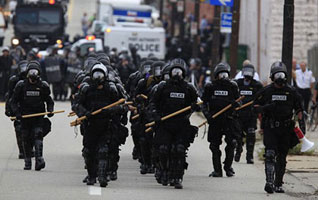 Last week, authoritarianism came back to Pittsburgh. Like any long-lost uncle, it came bearing gifts: national and international media exposure that would take $100 million to achieve, $35 million in cash injected into the local economy and a cavalcade of world leaders who took time from their oligarchies back home to admire the solidity of our fences and barriers Downtown.
Last week, authoritarianism came back to Pittsburgh. Like any long-lost uncle, it came bearing gifts: national and international media exposure that would take $100 million to achieve, $35 million in cash injected into the local economy and a cavalcade of world leaders who took time from their oligarchies back home to admire the solidity of our fences and barriers Downtown.
All authoritarianism wanted in exchange for these goodies was our soul — starting with our civil liberties. Our civic leaders, flattered by the “prestige” that comes with hosting a G-20 summit, quickly obliged. Who would miss a little thing like civil liberties, anyway?
For three days, Downtown was emptied of four-fifths of its population and replaced with 4,000 cops who spread out to different parts of the city when ordered to do so by some invisible democracy-hating high command.
The cops given the task of imitating Darth Vader’s storm troopers were a grim bunch. They volunteered to come here from other parts of the country, attracted by the mercenary pay and the opportunity to exert the kind of force on a civilian population their own civic leaders would never let them get away with. Pittsburgh now has the dubious distinction of being the only place outside Russia where sonic weapons were used on a civilian population.
Dressed entirely in black, the irony of the cops’ villainous-looking protective gear was lost to them but apparent to everyone they gassed, pepper-sprayed, knocked to the ground and arrested without cause. Yesterday, the city released a list of 190 people, including several journalists, arrested during the summit. Cameras were damaged and film destroyed in a clumsy and bare-knuckled attempt to abrogate the First Amendment.
“As a group the police responded admirably,” Mayor Luke Ravenstahl said resisting the urge to identify with people close to his age, but more diminished in power and stature. Mr. Ravenstahl could not afford to acknowledge what anyone with access to YouTube can see with their own eyes — that there was a full-scale breakdown in public order on the part of the cops. The images of the brutal assault on Pitt students and passers-by caught up in an indiscriminate and chaotic police sweep at the University of Pittsburgh on Friday night will surely be a cautionary tale to the next American mayor silly enough to consider hosting a G-20 summit.
An occupation like the one Pittsburgh experienced cannot help but change the way people view cops and their civic leaders going forward. For three days, thousands of militarized strangers took possession of our city, ostensibly to “protect” foreign and domestic leaders most of us would never see, much less meet. As one critic of the police action said during a news conference at the Thomas Merton Center yesterday, if the planners of future G-20 summits really want to ensure smooth, dissent-free experiences for the world’s leaders, why not have the conferences at military bases?
Security for the G-20 in Pittsburgh is put conservatively at $20 million. There was an estimated $50,000 in damage to windows and storefronts caused by anarchists in a few neighborhoods on the East End. But more than a few windows were broken last week. Something ghastly happened to us.
We proved we were willing to give up something very precious to us for a few days in the international spotlight. We invited authoritarianism into our homes and promised not to whimper while it danced on our necks.
[TOP]
Pittsburgh Police Statement on Massive Deployment Against Youth
Below is the official statement from the Pittsburgh Police Department justifying massive violence against youth September 25 in Schenley Plaza, a public park in Pittsburgh’s Oakland area, near the University of Pittsburgh.
* * *
On Friday, September 25, 2009 at approximately 8:45PM, Mobile Field Force Units were notified that a large crowd was beginning to converge on the Schenley Plaza [a public park] in Oakland.
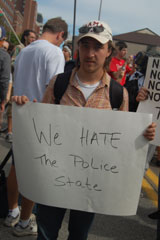 Through Intelligence it was learned that an un-sanctioned and un-permitted assembly was being planned in the Schenley Plaza area of Oakland. Notification of this un-sanctioned and un-permitted assembly was being distributed and monitored via Twitter and other social networking sites and a flyer was posted and distributed in various areas that indicated the actual meeting point to be Schenley Plaza at 10:00PM.
Through Intelligence it was learned that an un-sanctioned and un-permitted assembly was being planned in the Schenley Plaza area of Oakland. Notification of this un-sanctioned and un-permitted assembly was being distributed and monitored via Twitter and other social networking sites and a flyer was posted and distributed in various areas that indicated the actual meeting point to be Schenley Plaza at 10:00PM.
Further information was received throughout the day that individuals were purchasing numerous BIC lighters and asking if lighter fluid could be purchased. There is nothing to link the purchase of lighters to any activity, however the concerns of the PBP was heightened by the request for lighter fluid. Because of the prior night’s activity in Oakland, Mobile Field Force (MFF) presence was assembled at the ready to act swiftly and effectively to remove any violators conducting themselves in an unlawful manner. It was reported by the MFF stationed in Schenley Plaza that the crowd was becoming defiant and throwing things at the officers. Additional Mobile Field Forces were summoned.
At 7:20PM, Chief Delaney of the University of Pittsburgh Police sent two Emergency Notification System alerts (ENS) reaching out to the 51,000 Pitt students informing them of a pending G20 planned disturbance tonight; to be careful and exercise good judgment.
The second notification was sent at 10:04PM advising students that conditions of the activity may be deteriorating and students are advised to remain in residence.
The MFF Commander gave the Order to Disperse at 10:42PM. Orders for dispersal were given numerous times. The sound emitted from the LRAD (Long Range Acoustical Device) along with smoke was deployed in efforts to disperse the disorderly crowd, estimated at 1000. All who did not comply with the lawful order to disperse were taken into custody and arrested. A total of 110 individuals were transported to the SCI (State Correctional Institution) for processing.
There were no reported injuries to demonstrators and no property damage was reported during this incident. Two police officers were treated by EMS for minor injury: one for a dislocated shoulder and one for heat exhaustion. Information of those arrested is not available at this time. Once available it will be released.
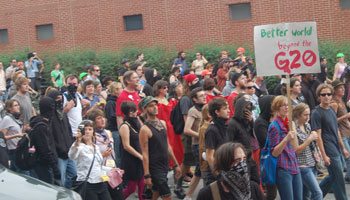
![]()
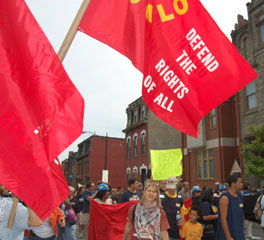
[TOP]

